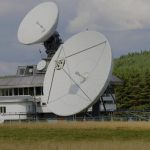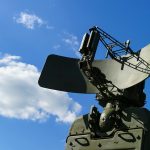RF over Fiber in Satellite Communication Systems: Simplifying Infrastructure, Amplifying Performance
As satellite communication continues to power everything from global broadcasting to GPS, defense, and internet connectivity, the demand for high-performance, low-latency signal transmission is more critical than ever. But maintaining signal quality between satellite antennas and ground control stations—often separated by long distances—can be a serious technical challenge.
That’s where Global Foxcom’s RF over Fiber (RFoF) technology steps in. By replacing traditional coaxial cabling with optical fiber, RFoF technology is dramatically improving signal integrity while simplifying satellite communication infrastructure.
What is RF over Fiber in Satellite Communications?
RF over Fiber involves transmitting radio frequency (RF) signals over optical fiber cables instead of coaxial cables. The RF signal is converted into a modulated light signal, sent through the fiber, and then converted back to RF at the receiving end.
In satellite systems, this means signals from antennas—often located far from the operations center—can be delivered with greater speed, clarity, and efficiency. This technology also lends itself to military applications, which Global Foxcom also supports and provides to a number of international military organizations.
Advantages of RFoF in Satellite Ground Stations
Why are RF over Fiber solutions increasingly being adopted in satellite communication infrastructure?
Improved Signal Quality Over Long Distances
Coaxial cables suffer from high signal attenuation, especially at the high frequencies used in satellite communications (e.g., L-band, S-band, Ka-band). Fiber optics, on the other hand, have extremely low loss—even over distances of several kilometers—preserving signal integrity end to end.
Lower Latency and Greater Bandwidth
Optical fiber offers near-instant transmission speeds and can support higher bandwidths compared to coaxial alternatives. In satellite systems, this translates to lower latency and improved support for data-heavy applications like HD video transmission and telemetry.
Immunity to Electromagnetic Interference (EMI)
Satellites operate in complex RF environments. Optical fibers, unlike metal cables, are immune to EMI—making them a robust and reliable option for noisy or mission-critical settings like space agencies, earth stations, and military tracking systems.
Simplified System Architecture
Replacing multiple coaxial runs with lightweight, flexible fiber can drastically reduce infrastructure complexity. Fewer signal boosters, smaller cable trays, and more centralized control units all contribute to easier maintenance and lower total cost of ownership.
RFoF Applications in Satellite Systems
RFoF applications are now commonplace across various types of satellite systems, including:
Earth Observation and Remote Sensing Stations
Many ground stations handling data from observation satellites use radio over fiber to carry signals from remote dish antennas to the control room, often located hundreds of meters or more away.
Military Satellite Communication (MILSATCOM)
RF over Fiber is key in defense environments where both security and performance are non-negotiable. Its resistance to interference and ability to support secure, high-frequency communication makes it ideal for military-grade satellite uplinks and downlinks.
Commercial Satellite Teleports
Teleport facilities—used to relay signals between satellites and terrestrial networks—are increasingly using RFoF technology to reduce complexity and increase reliability across multi-antenna systems.
Global Foxcom has widely adopted RFoF solutions in their satellite ground station products, providing reliable fiber links for long-distance RF signal transmission.
Looking Ahead: Fiber as the Future of Satellite Comms
As satellite networks evolve to support higher frequencies and larger constellations (like those powering global broadband), the need for scalable, high-performance ground infrastructure becomes even more pressing.
RF over Fiber solutions are the key to better performance with less complexity because they offer a future-ready approach—delivering the bandwidth, signal integrity, and simplicity required to keep up with the demands of modern space communication.




